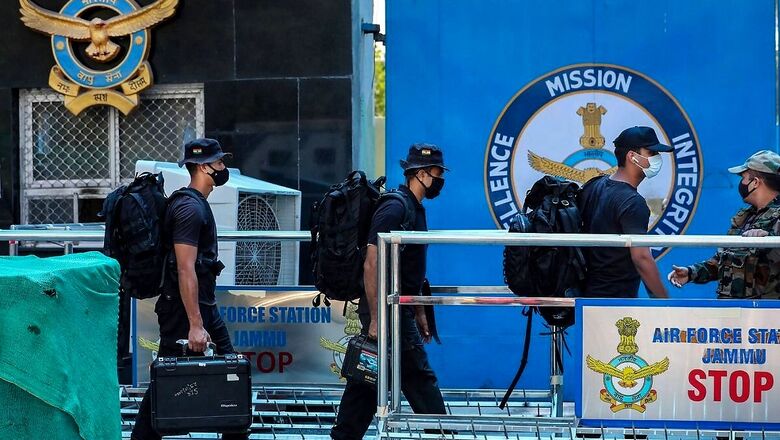
views
Eyewitnesses’ testimony has enabled the National Investigation Agency to piece together the route used by the drones which bombed Jammu airport last month, sources familiar with the case have told News18.
Investigators believe the attackers used two drones, which flew north of the shrine of Baba Budhan Ali Shah, in the airport complex, before taking a 180º turn after hitting their target and heading back west, in the direction of the India-Pakistan border.
The route — based on questioning sentries stationed along the airport’s western perimeter, behind the shrine, as well as inside the complex itself — suggests the drones likely flew a course high over the Tawi river, which leads to the India-Pakistan border, the sources said, before descending to stage the attack.
Forensic analysis has suggested that the explosive used in the attack was RDX, a widely-used military explosive, packed into what are known as shaped charges — which direct explosive energy so it can penetrate armour or concrete. Islamic State jihadists have used similar devices to attack multiple targets since 2017 — on one occasion, releasing video footage of a successful strike on an Iraqi-operated M1 Abrams battle tank.
“The explosive device seems to have been a simple device, triggered by its impact against the ground”, a military officer familiar with the investigation said. “You can easily rig conventional munitions for such a role”.
Even though there is no evidence so far on where the drones took off from or returned to, a Jammu Kashmir Police officer said multiple past investigations have suggested similar drones used to drop weapons in earlier cases were flown from locations across the border.
Last week, the police had arrested Nadeem Ayub Rather, a resident of Chak Cholend Herman near Shopian in Kashmir, and Talib-ur-Rehman, a resident of Kaskoot, near Ramban, alleging the two men were plotting to plant a 5 kilogram explosive device near the strategically-vital Banihal tunnel.
Investigations in that case, the police officer said, had shown that the explosive device recovered from the men was flown across the border to Narwal, near Jammu, by a drone, likely guided by a Global Positioning System.
The Banihal plot, an intelligence official told News18, had been detected on the basis of intelligence provided by the Research and Analysis Wing, , which had been monitoring a Lashkar-e-Taiba unit involved in earlier drone operations across the border. “It is hard to categorically say if the same unit, or some other Lashkar unit, was involved in the Jammu attack”, the official said, “but it is certainly possible”.
Finding electronic evidence of the route of a GPS-guided drone, an NIA officer familiar with the Jammy investigation said, was only possible if the navigation’s systems components could be recovered. GPS receivers are read-only systems, which receive signals from guidance satellites but do not transmit back to them.
“Without the GPS system”, the officer said, “there’s no way to tell what route a drone was programmed to follow, or whether the place the bombs fell was in fact the target”. “The chances are the full details of the Jammu attack will only become know if we are able to locate and arrest individuals involved in the operation”, he said.
Drone campaign
At least 30 drone sightings have been reported across the Jammu border region in the last month. Though some recent sightings are likely false — the result of guards on high alert mistaking planets or low-earth orbiting satellites for drones — there is evidence that several drops of weapons and explosives have taken place.
In June 2020, a drone carrying an M4 carbine, as well as ammunition, crashed at Maniari in Kathua, some 250 metres from the India-Pakistan border. Then, in September 2020, a drone delivered an M4, a Kalashnikov assault rifle, 6 pistols and ammunition, to a location near Samba, some 11 kilometres from the border. A third weapons drop, involving three Kalashnikovs, two pistols, 3 grenades and ammunition was made at Gurdian, near Rajouri, in the same month.
Two earlier drops made near the Line of Control in Rajouri, intelligence sources said, could not be interdicted, and the weapons they carried reached terrorists in the Shopian area in February or March 2020.
In other cases, drones are believed by authorities to have carried assembled IEDs to terrorist groups. Two consignments are believed to have been delivered through Rajouri in April, 2021, another three through Samba in May, 2021, and a third set at Akhnoor, in September 2020, an intelligence sources said.
The explosives devices brought in through these drone drops, the source said, were recovered by police in a series of raids running into early this year. “The payloads on these drops ran up to 15 kilograms”, an NIA officer said, “which is obviously much more than was used in the Jammu operation. That’s possibly because, in order to enable a long flight, the operators lowered the payload”.
For the most part, police sources say, drone flights have evaded detection except where prior intelligence was available, because of their small size and low engine noise.
The region around the Tawi River is made up of farmland, with large stretches of unpopulated marshes and elephant-grass. “Forces have a hard time even detecting human infiltration in some of these places”, one officer said, “let alone a tiny quadcopter flying silently several hundred feet over their heads”.
Read all the Latest News, Breaking News and Coronavirus News here.



















Comments
0 comment